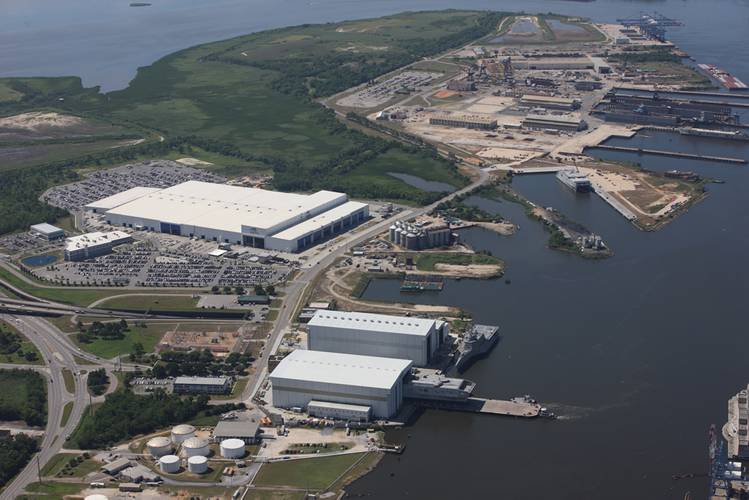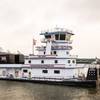Austal USA Powers Ahead
Austal USA has arguably been one of the more progressive and aggressive U.S. shipyards in its investment in technology, facilities and people. Austal USA President Craig Perciavalle took the helm a little more than six months ago, and Maritime Reporter was able to catch up with him recently for insights on pressing matters of the day.
You have been in the president’s chair at Austal USA for more than half a year; how is your mission different today than from when you were named to the top spot last December?
Honestly my mission has not changed much since December. After smoothly transitioning to the new position, my focus has been to continue providing the team here with the resources necessary to continuously improve and meet our commitments on each of our existing programs. My other mission is on expanding the business. We are fortunate to have a sizable backlog today but my focus is to continue growing the business and increasing our orderbook.
Coming into the position, what were your primary initiatives for the Austal USA operation, and have they changed?
Our primary initiatives consistently remain focused around safety, training, productivity improvements and cost reduction. Having the expansion of our manufacturing facilities essentially complete and in full operation, and having worked through first in class challenges on our programs, we have been able to stabilize our manufacturing processes and really zone in on opportunities for additional improvements.
The U.S. Navy is an important customer to Austal USA; can you give our readers a brief overview of the scope of work you conduct for the Navy?
We are currently under contract to build ships in two different newly-introduced U.S. Navy shipbuilding programs. The Independence-variant Littoral Combat Ship (LCS) is a sleek 127-m aluminum trimaran hullform designed to be the most advanced high-speed military craft in the world. This vessel is a fast, flexible Naval Combatant designed to operate in littoral waters across the globe.
Our second ship of this class, for which General Dynamics BIW is prime, is nearing completion. We also have a 10-ship contract for which Austal is prime, valued at $3.5 billion, of which three are under construction with the first scheduled to be launched by the end of the calendar year.
The Navy has also contracted Austal to build 10 Joint High Speed Vessels (JHSV); a contract worth $1.6 billion. The JHSV class of ships are 103-m aluminum catamarans designed to provide rapid intra-theater deployment/transportation of personnel, equipment and supplies. The vessel has the speed, volume and flexibility to perform multiple missions including but not limited to military logistics, sustainment and humanitarian relief operations at speeds of up to 43 knots. The first two ships have been delivered and are operating on the East Coast, while three more are under various stages of construction at this time.
How has Sequestration materially impacted your business to date? In the future?
Fortunately we have not been impacted by sequestration much at all. In a recent visit by the CNO, Admiral Greenert stated that sequestration would not affect projects already under contract and that has been the case. Going forward, we are confident that our relative low cost but highly flexible and capable solutions to the Navy, along with our ability to continue to deliver quality ships while meeting expectations, will put us in a favorable position with future business.
Austal USA arguably has been one of the more progressive U.S. yards in terms of investment in its operations and shipbuilding technology. That said, how is Austal investing today to ensure its tomorrow?
Overall, we’ve invested more than $300m in our facility here in Mobile, most of which was completed within the last couple of years. Our focus has been investing in People, Plant and Processes. Quite frankly, we’ve completely transformed how we build ships and manage our business, with very little, if anything, being done today the same way it was done back in 2008. With the facility and process growth came employment growth, with significant focus placed on training and skills enhancement. With tremendous help from the State of Alabama, we’ve developed a top notch training program that has enabled us to grow in total employment from about 800 in 2009 to over 3,500 today. These investments have enabled us to successfully support two first-in-class Navy programs and we feel this has put us in a very competitive position going forward.
For example, June was a very busy month here: we launched JHSV 3; delivered JHSV 2; then laid the keel for LCS 8, showing the manufacturing lines are in full operation.
Business is fraught with challenges every day. What do you count as the top challenges to building and maintaining an efficient, profitable shipbuilding operation?
As can be expected, our primary challenges have centered around the rapid facility and employment growth we’ve experienced over the past few years while supporting two first-in-class programs. With expansion and employment growth come challenges in maintaining safety and increasing skill base. Fortunately, we’ve been able to see significant improvements in both these areas despite the growth.
Regarding safety, despite growing total employment from under 1,000 to over 3,500 in just a few short years, we’ve successfully focused on improving the working environment of our employees as evidenced by receiving the Shipbuilders’ Council of America (SCA) award for Excellence in Safety for the fourth consecutive year. This is a direct result of the hard work and intense focus of all of our personnel, as well as their ultimate commitment to each other’s safety. Although our safety performance is nationally recognized, our focus remains on continuing to improve and provide our employees with the safest work environment possible.
To help increase our skill base, Austal has teamed up with Alabama Industrial Development Training (AIDT) to develop a 60,000 sq. ft. onsite training facility and program to support our needs. This program is designed to provide an intense training opportunities for all trades; both existing Austal employees who desire to increase their skills for career advancement, and pre-hire candidates to facilitate their ability to rapidly assimilate into the workforces. Austal also recruits 50 to 100 people twice per year to participate in our Apprentice Training Program which has successfully graduated four, four-year classes into our workforce in the last six years.
(As published in the August 2013 edition of Maritime Reporter & Engineering News - www.marinelink.com)














